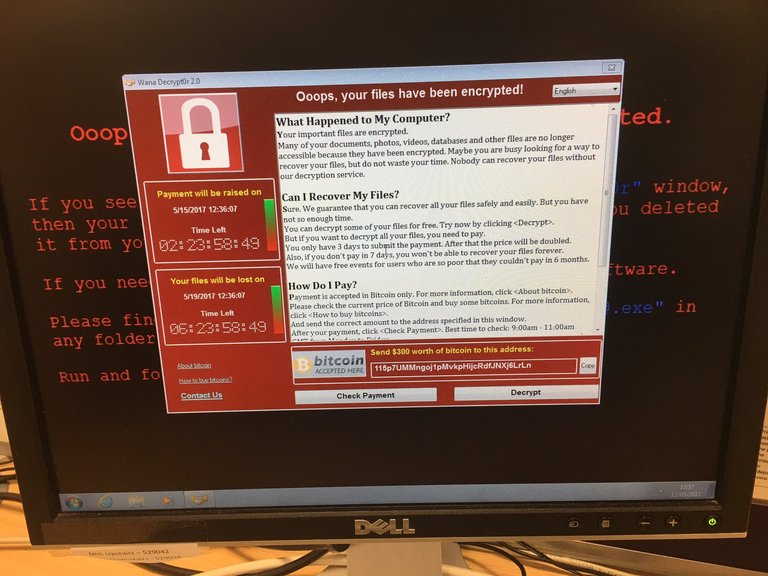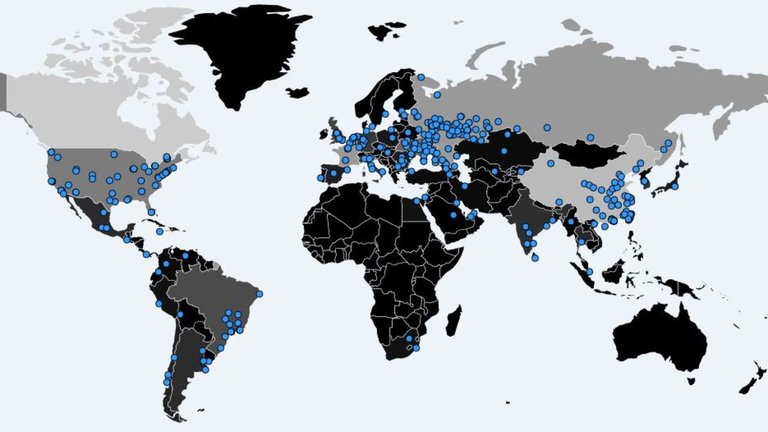Hospitals, Rail Networks, Police Stations, major companies and government offices have been hit by a massive wave of cyberattacks On 12 May 2017 across the globe that seize control of computers until the victims pay a ransom.
Cybersecurity firm Avast said it tracked more than 75,000 ransomware attacks in 100 countries on Friday.
It said the majority of the attacks targeted Russia, Ukraine and Taiwan. But hospitals in the U.K., and global firms like Fedex also reported they had come under assault.
America, All Europe Country's, Africa, Ukraine and India were also severely affected.
In Brief What it can Do
Ransomware Virus Will Encrypt All of your Computer files and Demands you to pay $300-$600 to Decrypt the Files/Restoring it. It Mainly Targets the Windows Based System. because it's Based one of the loophole of Windows O.S
How to Escape from it
Ransomware WannaCry uses a SMB vulnerability, which means it can spread across networks without you opening any files. More Details about SMB Vulnerability and How to Update your Windows is Here https://support.microsoft.com/en-us...lity-in-smb-could-allow-remote-code-execution It's also Recomeneded to Don't open the Random files from the internet, beware of unknown emails never Open them etc.,
WASHINGTON DHS Statement
WASHINGTON – The Department of Homeland Security is aware of reports of ransomware known as WannaCry affecting multiple global entities.
Ransomware is a type of malicious software that infects a computer and restricts users’ access to it until a ransom is paid to unlock it. Microsoft released a patch in March that addresses this specific vulnerability, and installing this patch will help secure your systems from the threat. Individual users are often the first line of defense against this and other threats, and we encourage all People to update your operating systems and implement vigorous cybersecurity practices at home, work, and school.
These practices include:
Update your systems to include the latest patches and software updates.
Do not click on or download unfamiliar links or files in emails.
Back up your data to prevent possible loss, whether you are at a home, work, or school computer.
What is it?
The ransomware, called "WannaCry," locks down all the files on an infected computer and asks the computer's administrator to pay in order to regain control of them. The exploit was leaked last month as part of a trove of NSA spy tools.
The ransomware is spread by taking advantage of a Windows vulnerability that Microsoft (MSFT, Tech30) released a security patch for in March. But computers and networks that hadn't updated their systems were still at risk.
In the wake of the attack, Microsoft said it had taken the "highly unusual step" of releasing a patch for computers running older operating systems including Windows XP, Windows 8 and Windows Server 2003.
"Affected machines have six hours to pay up and every few hours the ransom goes up," said Kurt Baumgartner, the principal security researcher at security firm Kaspersky Lab. "Most folks that have paid up appear to have paid the initial $300 in the first few hours."
Original Screen Shot of Ransomware affected System

Ransomware ScreenShot C_n7v4BWsAAi8Sb.jpg
Sixteen National Health Service (NHS) organizations in the UK have been hit, and some of thosehospitals have canceled outpatient appointments and told people to avoid emergency departments if possible. Spanish telecom company Telefónica (TEF) was also hit with the ransomware.
Spanish authorities confirmed the ransomware is spreading through the vulnerability, called "EternalBlue," and advised people to patch.
"It is going to spread far and wide within the internal systems of organizations -- this is turning into the biggest cybersecurity incident I've ever seen," UK-based security architect Kevin Beaumont said.
You can Follow by #WannaCry #ransomware on Twitter
Country's Affected by Ransomware Virus Cyber Attack

Really It's a Biggest Massive Cyber Attack , Country's like London, Russia, Taiwan, China are affected More than the other.
Fedex said it was "experiencing interference with some of our Windows-based systems caused by malware" and was trying to fix the problems as quickly as possible.
Russia's Interior Ministry released a statement acknowledging a ransomware attack on its computers, adding that less than 1% of computers were affected, and that the virus is now "localized." The statement said antivirus systems are working to destroy it.
Megafon, a Russian telecommunications company, was also hit by the attack. Spokesman Petr Lidov told CNN that it affected call centers but not the company's networks. He said the situation is now under control.
The U.S. Department of Homeland Security, in a statement late Friday, encouraged people to update their operating systems. "We are actively sharing information related to this event and stand ready to lend technical support and assistance as needed to our partners, both in the United States and internationally," the department said.
Kaspersky Lab says although the WannaCry ransomware can infect computers even without the vulnerability, EternalBlue is "the most significant factor" in the global outbreak.
How to prevent it
Beaumont examined a sample of the ransomware used to target NHS and confirmed it was the same used to target Telefónica. He said companies can apply the patch released in March to all systems to prevent WannaCry infections. Although it won't do any good for machines that have already been hit.
He said it's likely the ransomware will spread to U.S. firms too. The ransomware is automatically scanning for computers it can infect whenever it loads itself onto a new machine. It can infect other computers on the same wireless network.
"It has a 'hunter' module, which seeks out PCs on internal networks," Beaumont said. "So, for example, if your laptop is infected and you went to a coffee shop, it would spread to PCs at the coffee shop. From there, to other companies."
"This is an unprecedented scale. We've never seen something spread this quickly in a 24-hour period across these many countries and continents.
"So it's definitely one of those things we've always heard about that could happen and now we're seeing it play out. It's really a cyber-apocalypse that we're seeing."
Mikko Hypponen, from tech firm F-Secure, called it "the biggest ransomware outbreak in history".
Chris Wysopal of the software security firm Veracode said criminal organisations were probably behind the attack, given how quickly the malware spread.
"For so many organisations in the same day to be hit, this is unprecedented," he said.
Spain's Telefonica, a global broadband and telecommunications company, was among the companies hit.
Portugal Telecom and Telefonica Argentina both said they were also targeted.
The software used in the latest attacks is called WannaCry, or Wanna Decryptor, and exploits a vulnerability in the Windows operating system.
It allows the malware to automatically spread across networks, so it can quickly infect large numbers of machines at the same organisation.
The Cyber extortionists tricked victims into opening malicious attachments to spam emails that appeared to contain invoices, job offers, security warnings and other legitimate files.
The ransomware encrypted data on the computers, demanding payments of $300 to $600 to restore access.
Spain took steps to protect critical infrastructure in response to the attack.
Authorities said they were communicating with more than 100 energy, transportation, telecommunications and financial services providers about the attack.
Hi! I am a robot. I just upvoted you! I found similar content that readers might be interested in:
https://www.youtube.com/watch?v=2YLVhLPL_3AWell described